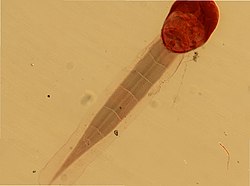Urochordata Classification
Classification of Urochordata
Subphylum Urochordata is divided into three classes.
CLASS 1. ASCIDIACEA CLASS 2. THALIACEA CLASS : 3 . LARVACEA (APPENDICULARIA)

CLASS 1. ASCIDIACEA:
1. These are sedentary tunicates.
2. The body is covered by a test.
3. Pharynx is large and contains gill-slits.
4. Notochord, nerve-cord and tail are absent
5. These are Bisexual animals.
6. Life-history includes a typicalTadpole larva. The class Ascidiacea is divided into two orders.
Order 1. Enterogona
These ascidians bear one gonad in the intestinal loop. Neural gland is ventral to the ganglion. Tadpole larva is seen:
Ex: Ascidia and Ciona.
Order: 1. Pleurogona:
In these ascidians,gonads are paired and are present in the atrial wall. Neural gland is dorsal to the ganglion:
Ex : Herdmania, Botryllus.
Ascidiacea

CLASS 2. THALIACEA :-
1. These Urochordates are free-swimming and pelagic forms.
2. They are covered by transparent test.
3. The brachial and atrial apertures are placed at anterior and posterior ends.
4. Pharynx is small.
5. Gill-slits number is less.
6. Notochord, nerve-cord and tail are absent in the adult.
7. Asexual reproduction is by budding.
‘8. These are bisexual animals.
9. Tailed larva may be present or absent.
10. Alternation of generations can be seen in the life history.
The class thaliacea is divided into three orders.
1. Doliolida, 2. Pyrosomida and 3. Salpida.
Order 1. Doliolida (Cyclomyarla)
1. Barrel shaped body is completely covered by Muscle bands,
2. Pharynx is small
3. Number of gill slits will be small.
4. Tailed larva is seen
5. Sexual Blasto-zooid and asexual oozooid stages will alternate in the life cycle.
Ex :Doliolum.
Order 2. Pyrosomlda :
1. This order includes colonial forms.
2. Muscle bands are small and present at the ends.
3. Gill-slits are many.
4. Tailed larval stage is absent.
Ex : Pyrosoma (Luminescent colonial form).
Order 3. Salplda (Hemimyaria) :-
1. This order includes organisms whose body is prism like.
2. Muscle bands are complete dorsally and incomplete ventrally.
3. Only one pair of lateral gill slits are present.
4. Tailed larval stage is absent.
5. Life history includes alternation of generations.
Ex: Salpa.
Pyrosoma atlanticum, a pyrosome
CLASS : 3 . LARVACEA (APPENDICULARIA)
1. These are free - swimming, pelagic tunicates.
2. True’ test covering is lacking
3. They show loose gelatinous house.
4. This house is useful for filter feeding.
5. Two gill slits re present.
6. Atrium is absent. ..
7. Notochord and nerve cord are Persistent
8. They show tail throughout their life.
9. Neotenic forms are included.
Ex: Oikopleura. ‘
Appendicularia sp., a genus of fritillariid larvacean


